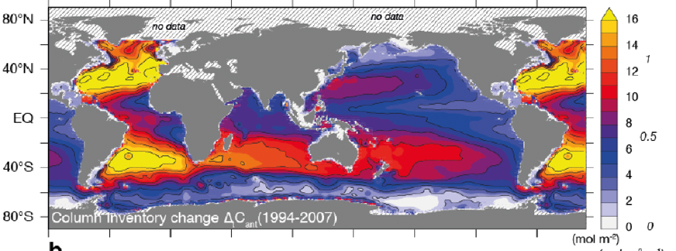
The world’s oceans are helping to combat global warming. An international team of scientists, including University of Hawaiʻi at Mānoa Professor of Oceanography Christopher Sabine at the School of Ocean and Earth Science and Technology (SOEST), has shown that the ocean is absorbing carbon dioxide (C02), generated during the combustion of fossil fuels, from the atmosphere at an increasing rate from the 1990s to the early 2000s.
As reported in the latest issue of Science, the researchers found that the ocean has taken up as much as 34 gigatonnes (billions of metric tonnes) of human produced carbon between 1994 and 2007. This figure corresponds to 31 percent of all human-produced C02 emitted during that time.
“The uptake and storage in the ocean of human-produced C02 has significantly decreased the climate change effects the planet has seen so far,” said Sabine. “Getting a handle on how much more the ocean can take is critical for predicting future climate change impacts.”
The ocean as a sink for carbon
The ocean takes up C02 in two steps. First, the C02 dissolves in the surface water. Afterward, the ocean’s overturning circulation—ocean currents and mixing processes—slowly transports the dissolved C02 into the ocean’s interior, where it accumulates over time.
This overturning circulation is the driving force behind the oceanic sink for C02, because it makes room for the surface ocean to absorb more C02. Without this sink, the concentration of C02 in the atmosphere and the extent of anthropogenic climate change would be considerably higher.
Starting in 2003, scientists from seven countries, including Sabine, participated in an internationally coordinated program wherein they carried out more than 50 research cruises globally over 10 years. They measured C02 and other chemical and physical properties from the surface down to depths of six kilometers to create a three-dimensional picture of ocean chemistry.
To determine the increase in the oceanic C02 content as a result of the oceanic uptake of human produced C02 from the atmosphere, they contrasted the measured C02 concentration from this new survey to a synthesis, led by Sabine, of observations obtained from a global C02 survey conducted between the late 1980s and the mid-1990s.

The marine sink is intact
As the atmospheric concentration of C02 rises, the absolute quantity of C02 taken up by the oceans increases. The oceanic sink strengthens more or less proportionally: The more C02 is in the atmosphere, the more it is absorbed by the oceans—until it eventually becomes saturated.
So far, that point has not been reached.
“Over the examined period, the global ocean continued to take up anthropogenic C02 at a rate that is congruent with the increase of atmospheric C02,” said Nicolas Gruber, professor for environmental physics at ETH Zurich and lead author of the new study.
Added Sabine, who joined SOEST in 2018, “By comparing our early assessment to this recent analysis, we have confidence that the marine carbon sink is still intact, which is reassuring, but it comes at a price.“
For the full story, see the SOEST website.
—By Marcie Grabowski

